
An approach for eliminating racial disparities in breast and lung cancer treatment and research on huge costs associated with prior authorizations were among topics highlighted October 25 at the American Society for Radiation Oncology (ASTRO) 2021 annual meeting in Chicago.
In a news briefing, U.S. researchers shared top-rated abstracts presented at the meeting, including findings on the underuse of external-beam radiation therapy for people with liver cancer awaiting transplant.
Eliminating racial survival gaps
 Dr. Matthew Manning.
Dr. Matthew Manning.System-level changes to the way cancer care is delivered can also eliminate Black-white disparities in survival from early-stage lung and breast cancer, according to a presentation by Dr. Matthew Manning, chief of oncology at Cone Health in Greensboro, NC.
"Studies have looked at racial disparities in health care, but until recently, very few studies have implemented interventions to eliminate those disparities," Manning said.
Manning and colleagues, including researchers at Duke University and the University of North Carolina, presented five-year follow-up data on the NIH-sponsored Accountability for Cancer Care through Undoing Racism and Equity (ACCURE) trial.
The ACCURE intervention involves four components:
- An electronic health record with automatic alerts to flag missed appointments or unmet milestones in expected care
- A nurse navigator trained in race-specific barriers to help patients overcome obstacles to care when alerts are flagged
- A physician champion, to engage health care teams with race-related feedback on treatment completion
- Regular health equity education training sessions for staff
Prior to the intervention, the five-year survival rate for Black patients with breast cancer was 89%, compared with 91% for white patients. After the system-level changes were initiated, five-year survival rates for both groups rose to 94%. Among those treated for early-stage lung cancer, survival rates increased from 37% to 54% for Black patients and from 43% to 56% for white patients.
"Historically, Black and white patients had different survival rates after treatment, but that difference disappeared. We are now able to say that this intervention eliminated disparities in overall survival," Manning concluded.
Moving forward, the researchers are considering other applications for the intervention, such as addressing disparities in pregnancy and maternal care.
"We think the application can be much broader," Manning said.
A huge cost burden
The time required to secure prior authorization for radiation therapy treatments equates to a financial impact of more than $40 million annually for academic medical centers, according to a presentation by Dr. Brian Bingham, lead study author and chief radiation oncology resident at Vanderbilt University Medical Center in Nashville, TN.
 Dr. Brian Bingham.
Dr. Brian Bingham."We expected that prior authorization was expensive, but the degree of expense was eye-opening," Bingham said.
This was the first study to analyze the financial impact on radiation oncology of the time attending physicians spend on prior authorizations, according to Bingham.
Bingham and colleagues at Vanderbilt first looked at their own department and found they were spending about $500,000 in employee time per year to obtain prior authorization for radiation therapy treatments. The average compensation cost per request ranged from $27.51 for treatments that were initially approved (63% of all requests) to $100.55 when the insurance company required a peer-to-peer discussion.
The team then used response data from a 2018 ASTRO survey on prior authorization to estimate annual costs for all academic medical centers nationally. The group found annual treatment-related prior authorization costs were estimated at about $40 million for all academic practices nationally, with subsequently approved treatments accounting for the vast majority, about $36 million.
"Something must be done to decrease this burden," Bingham said.
At the institutional level, practices can examine their own process maps for prior authorization management to look for potential inefficiencies and find ways to increase communication between the employees involved in securing approvals, Bingham suggested.
EBRT underused in liver cancer
People with liver cancer awaiting transplantation could benefit from noninvasive radiation treatments, such as external-beam radiation therapy (EBRT), yet rarely receive it, according to a group of radiation oncologists at Oregon Health & Science University in Portland, OR.
Associate professor Dr. Nima Nabavizadeh and colleagues presented an analysis of data from the United Network for Organ Sharing (UNOS). They aimed to determine which bridging therapies were prescribed most often.
 Dr. Nima Nabavizadeh.
Dr. Nima Nabavizadeh.Out of the 18,477 patients identified with hepatocellular carcinoma (HCC) awaiting transplant since 2013, the team found 85.4% received some type of bridging therapy. Just 3.6% of those patients were treated with EBRT, however, either alone (1.2%) or in combination with another type of therapy (2.4%).
TACE was the most utilized therapy, used for 39.6% of patients. Thermal ablation was used for 12.8% of patients, and radioembolization was used for 8.7% of patients. Nearly a quarter of patients (22.2%) received a combination of non-EBRT therapies, the researchers found.
"Using our own institutional experience, more than 4% of our patients get EBRT at some point, so 3.6% was a surprising figure to us," Nabavizadeh said.
Radiation is the only non-invasive option and has not been shown to be inferior to the other treatments, he added.
Nabavizadeh noted the study did not explore why patients were prescribed one treatment over another, but he suggested it could be because radiation oncologists are often left out of the management discussions for these patients.
"Radiation needs to be part of treatment discussions much more frequently than it is now," Nabavizadeh concluded.




















